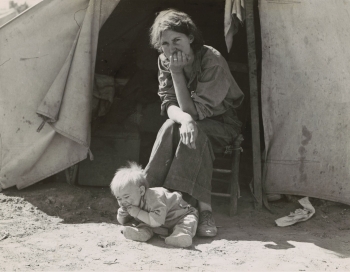“The state of female artists is very good. But the very definition of art has been biased in that ‘art’ was what men did in a European tradition and ‘crafts’ were what women and natives did.” —Gloria Steinem
Here, feminist icon Gloria Steinem points out that there is no shortage of women and Indigenous artists—but that pervasive notions of what counts as “art” have excluded them from mainstream recognition. Steinem calls out the ways in which materials and subjects can be assigned different cultural values.
Art materials and forms have acquired gendered associations over time. For example, oil painting and sculpture were once framed as high-minded masculine pursuits valued more highly than other artistic media. Practices such as quilting, sewing, or weaving that produced utilitarian objects were relegated to the female and domestic sphere. Works on paper—including watercolor and drawing, which often use less expensive materials—have been associated with female pursuits, taught along with embroidery and sewing as part of a girl’s genteel education. Works executed using these materials have also been viewed as “supporting” work—preparation for oil painting, sculpture, or architecture—rather than as independent art forms. The subjects of works of art have also reflected biases. In much Western and European art, historical and mythological narratives were highly valued and intellectualized, while those relating to daily or home life, most often, were not.
In modern and contemporary art, feminist artists have challenged these value judgments. They have embraced a broad variety of materials and treated new subjects, creating works that have made women’s experiences, accomplishments, and lives visible.
Invite students to examine the works of art in the image set, reading the descriptions and learning about the artists’ lives and works. How do their choices of art materials or subject relate to or challenge cultural ideas about gender?





